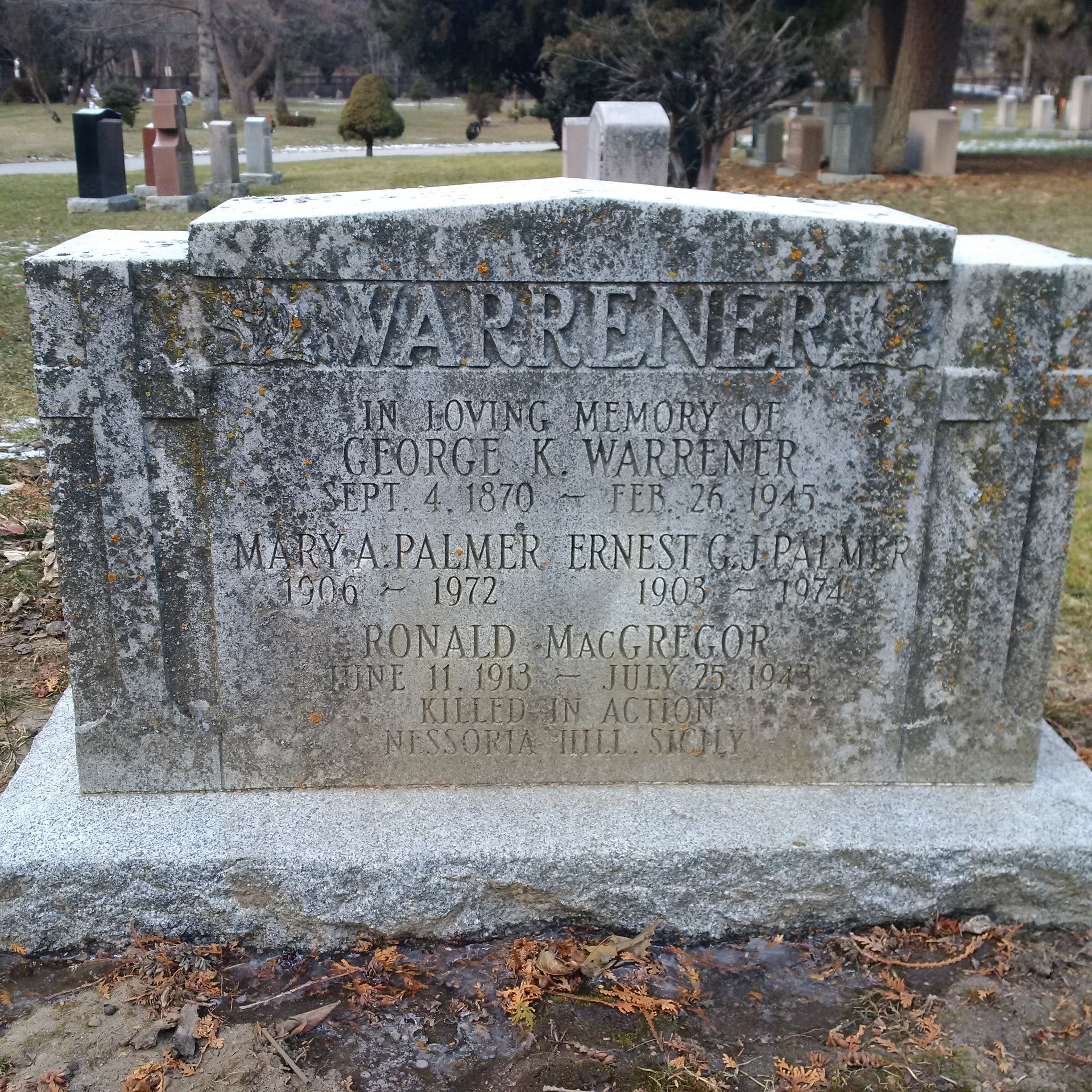Be warned, this is a long post and covers quite a few digitized non-computer indexed collections to pull all the parts together. Yet it also highlights some of the skills needed to be developed beyond using the search systems on most genealogy sites.
Lorraine Foley posted:
Michael Cavanagh, born Ireland abt 1781 , was a soldier in France in 1817, had a child there, came to Canada 1818, and raised family around Perth or Huntley, Ontario. I have seen some military record possibilities, but without collaborating info, I don't know which one is him. I assume he was given land.
Lorraine provided some good bits of information but I needed a bit more. So after I posted a possible lead to a Sgt. Michael Cavanaugh who settled on lot 12 of the 9th concession in Bathurst township she replied back with:
The earliest I can find Michael is in the Richmond and Perth church records. The 1851/61 census state family lives in Huntley township. I am having no luck finding lot # for him in the land record sites mentioned by others below.
That little bit of information about finding Michael in the 1851 and 1861 census enumerations of Canada West allowed me to start digging into the property records.
The first step for me would be to put the family "on the ground" and to locate them in the population schedule for the 1851/52 census and then find him hopefully in the agricultural schedule since that would provide me with a concession and lot number. But since so many of the agricultural schedules for the 1851/52 census of Canada West have been lost to the ravages of time I usually check the "Districts and Sub-districts: 1851 Census" page for Canada West on the Library and Archives Canada site before looking for something which might not exist. Huntley is in District 4, Carleton County and as we can see, the agricultural census is missing for the Huntley sub-district.
| Sub-District Number | Sub-District Name | Microfilm | Notes |
|---|---|---|---|
| 24 | Fitzroy | C-11716 | |
| 25 | Gloucester | C-11716 | Agricultural census is missing. |
| 26 | Goulbourne | C-11716 | Agricultural census is missing. |
| 27 | Gower | C-11716 | Agricultural census is missing. |
| 28 | Huntley | C-11716 | Agricultural census is missing. |
| 29 | March | C-11716 | Agricultural census is missing. |
| 30 | Marlborough | C-11716 | Agricultural census is missing. |
| 31 | Nepean | C-11716 | Agricultural census is missing. |
| 32 | Osgoode | C-11716 | Only the agricultural census has survived. |
| 33 | Richmond | C-11716 | Agricultural census is missing. |
| 34 | Torbolton | C-11716 | Agricultural census is missing. |
That is unfortunate but not unexpected. So on to the 1861 census since most of those agricultural schedules did survive.
I've already written about some of the challenges in using the 1861 Census of Canada West in my posts "A Challenge: 1861 Census of Canada - Agricultural Schedule" and "Missing images from the 1861 Census of Canada West on Ancestry?" but fortunately, at least in this case, I didn't run into these issues for Michael Cavanagh since I was only looking for the concession and lot details. However, there were other challenges (aren't there always!)
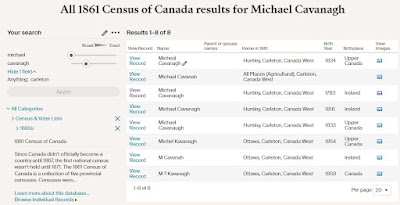 |
| Screen capture of the results from searching the 1861 Census of Canada collection on Ancestry for Michael Cavanagh with the exact keyword of "carleton". |
We find that there are several Michael Cavanaghs (with various spellings) in the Carleton district with their home in the Huntley sub-district. Only one stood out to me and that was the Michael Cavanaugh born in 1783 in Ireland since he matched the information provided my Lorraine. He was found in enumeration district number 7. However, to be on the safe side I checked the others:
- Michael Cavenagh born 1816 in Ireland is recorded as single residing in enumeration district no. 5,
- Michael Cavanagh born 1834 in Upper Canada is recorded as single residing in enumeration district no. 1 possibly in the household of John Cavanagh, and
- Michael Cavanagh born in 1833 in Upper Canada is recorded as single residing in enumeration district no. 7 apparently in the household of the Michael Cavanaugh born 1873 in Ireland.
There is also that Michael Cavanah without a birth year and birth place with a home of "All Places (Agricultural), Carleton, Canada West. Looking at the image we can see that it is for the agricultural schedule for enumeration district no. 7 in the Township of Huntley in Carleton County.
Here we find a "Michael Cavanah" with property on lot 27 of the 11th concession in Huntley Township, Carleton County, Canada West. This looked very promising and Lorraine was able to confirm that was her "Michael Cavanagh".
That covers the easy work which most of us can do once we are familiar with using any of the major genealogy sites and searching the various censuses of Canada. Now we move away from the usual collections and on to Ontario land records and the challenges of looking at digitized microfilms.
Since we can now place Michael on the ground on lot 27 of the 11th concession in Huntley Township we can see if we can find him in the historical Abstract/Parcel Register Books within the Ontario Land Property Records Portal (AKA OnLand) or in the Abstract index books collections in the "Land and property" category for "Canada, Ontario, Carleton" on FamilySearch.
I personally like using the collections on FamilySearch since I don't have to worry about if OnLand is open for business when I'm searching Ontario land records late at night. Here is the start of the page for lot 27 on concession 11 in Huntley Township.
 |
| Abstract index books, ca. 1800-1959, of Carleton County, Huntley Township (v. A), Lot No. 27 Concession 11; Registrar's Office, Ottawa, Ontario; DGS 8,344,621, image 274, FamilySearch (https://www.familysearch.org/ark:/61903/3:1:3Q9M-CSTY-Z9FM-9 : accessed 16 Feb 2022). |
It was fairly easy to find but it seems he received the land not from the Crown, like one might expect if it was from a grant, but from the Canada Company on 11 Apr 1835. He then sells the property to a Michael T Cavanagh on 23 Jul 1851...possibly his son?
Yet what got my attention was on the preceding page for the East 1/2 of lot 26 in the 11th concession of Huntley Township.
 |
| Abstract index books, ca. 1800-1959, of Carleton County, Huntley Township (v. A), East half Lot No. 26 Concession 11; Registrar's Office, Ottawa, Ontario; DGS 8,344,621, image 274, FamilySearch (https://www.familysearch.org/ark:/61903/3:1:3Q9M-CSTY-Z9FM-9 : accessed 16 Feb 2022). |
Here a Michael Cavenagh received the land as a patent from the Crown on 13 Oct 1836 and then he sells it on 9 Mar 1937 to Andrew Whelan.
OK, time to pull in the sails and try another tack. Can I find information about that patent which was granted on 13 Oct 1836 on lot 26? Keep in mind that a patent isn't granted until all of the required duties to be performed on the land have been completed. So it may be a number of years from the time a petition is granted until a patent has been received.
This time it is over to the "Land Petitions of Upper Canada, 1763-1865" database at Library and Archives Canada. I've learned that for names which may have multiple interesting ways of being spelled to put in the minimum number of letters in the LAC database search system so I searched on the surname of "cav" and the given name "michael"
 |
| Screen capture of the results searching the Land Petitions of Upper Canada, 1763-1865 database on Library and Archives Canada for the surname "cav" and given name "michael". |
Two results got my attention: the 1829 and the 1823 petitions. The 1848 petition is much too late for the patent granted in 1836.
Let's take a look at the 1823 petition found in the Upper Canada Sundries on microfilm C-4611 first since it is the earliest petition. The Upper Canada Sundries have been digitized on Héritage site of the Canadian Research Knowledge Network.
A search for microfilm C-4611 displays "Upper Canada Sundries : C-4611" at the top of the search results. Even better, almost all the pages have full-text search support. Searching for "cavanagh" gave me two matching pages: image 119 and image 781. Looking at image 119, in the top corner I could see "32254" stamped. This didn't match what was in the results from the Land Petitions of Upper Canada, 1763-1865 at LAC. However, image 781 has "32921" stamped in the corner and that is a number we want to see.
In this letter dated 13 Oct 1823 we learn some of the following details about Michael Cavanagh:
- he was with the 57th Regiment of Foot
- he was discharged in Vallencenes [Valenciennes] in France
- he has been in Upper Canada for nearly three years
- when he first went to apply for land he had four in his family left in Ireland
- he initially applied in Lanark to get his "military locations" but was told the "land was of no use there was nether rations or utinsial alowed for me an to go an get my family before I trobled myself with land..."
- it seems his family landed in St. John, New Brunswick and he has returned to Brockville, Upper Canada with his family
Alas, no details about if he was given land and where. Time to look at the next petition from 1829.
The microfilms for the RG 1 L3 reference are found in an archived microform collection on the LAC site. Most of the time I can't recall how I bookmarked it in my browser so I click on the "How to obtain copies" link found on the left side of the page where the results are displayed. There LAC has provided a link to "Upper Canada Land Petitions - Microform digitization". Microfilm C-1725 was easy to find and I clicked on that link.
After a bit of bouncing around the images I was able to relatively quickly find Upper Canada Land Petitions "C" Bundle 16, 1825-1831 (RG 1, L 3, vol. 109). That sort of information is supposed to be at the bottom of each microfilm image. The petition number is written at the top of the page in one of the corners. The first page of the bundle will just be a number and the subsequent pages will include a letter like "16a" followed by "16b", etc.
Here is the first of several pages from Michael Cavanagh's petition from 1829.
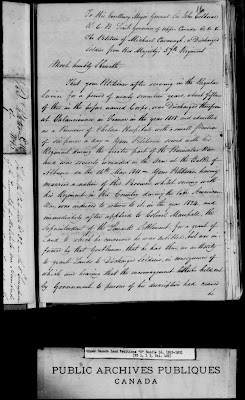 |
| Upper Canada Land Petitions "C" Bundle 16, 1825-1831, Petition 16, page 1 of the petition of Michael Cavanagh; RG 1 L3, vol. 109, microfilm C-1725, images 758; Library and Archives Canada, Ottawa. |
- he was a discharged soldier from his Majesty's 57th Regiment of Foot,
- he was discharged at Valanciennes [Valenciennes] in France in 1818,
- he served in the Peninsula War,
- he was admitted as a pensioner of Chelsea Hospital with a small pension of 6 pence a day,
- he was wounded in the arm at the Battle of Albuera on 16 May 1811, and
- he now has five children to support.
It looks like he didn't get the reply he wanted from his 1823 petition and tried again but this time addressing it to the newly arrived Lieutenant Governor of Upper Canada His Excellency Major General Sir John Colborne KCB. It also seems that Michael served in the same brigade under Sir John.
Only one problem with this bundle...I didn't see any mention of what land was being granted to him only "In Council 6th Nov 1829 recommended as a discharged soldier for 100 acres". But at least we know that this petition was successful.
So it was off to the Ontario Crown Lands collection RG 1, C-I-3 which I had looked at in my post "Ontario Crown Land RG 1 C-I-1, C-I-2, C-I-3 Collections on FamilySearch". In that collection I had noticed a number of bundles for "Military warrants" on later pages.
Looking through the "RG 1, C-I-3, vol. 124, Register for Military Warrants" found in the digitized collection on FamilySearch under "Military warrants (v. 124-125) 1799-1869 (indexed) Locations to discharged soldiers and seamen (v. 126) 1815-1822 (indexed) Nominal return of troops entitled to land for service in the War of 1812-1814 (v. 127) Photostatic copy of v. 127, Prince Regent's land grant to Flank companies militia U.C. War of 1812-1814 (v. 127A)" in FHL 1376096 / DGS 8346076 I found a Michael Cavanagh listed in the hand written index at the start with a reference to folio 47. Based on my experience that meant I needed to look for page 47 in this register.
Above is the entry in this register for Michael Cavanagh. It is recorded that he is a "Soldier from the 57 Regiment of Foot As a discharged Soldier". What is even better is that it gives the location of the property as E 1/2 Lot 26 on the 11th Concession in Huntley. It was by the authority of OC 6 Nov 29 [Order in Council 6 Nov 1829] just like we saw in the bundle of his 1829 petition. This document ties the Michael Cavanagh found in the Land Petitions of Upper Canada to that property we found in the Abstract index books.
But we can't stop there since it gives a number for the warrant: T 20.
With a little bit of trial and error (how FamilySearch labels their collections can be a trial at times) I found the warrant in "Military warrants (v. 111-112) bundle A10-Z12, 1823-1829" (FHL 1376008 / DGS 8346063) under "R.G. 1, C-I-3, Vol. 112, Military Warrants, Bundle A19-Z21" starting at image 1294.
Looking within that bundle what do I see but a note from A Whelan...that same Andrew Whelan we saw in the Abstract index.
There is another place we can look for possible information about a property and that is in the Township Papers also found on FamilySearch within the Land and property category of "Canada, Ontario". There are actually two collection and both are labelled "Township papers, ca. 1783-1870's". One goes from A to H and the other goes from H to Z. What makes this a bit frustrating is that the index is not quite alphabetical by township name. So sometimes it takes a bit of effort to find the digitized microfilm for the township you are wanting. In the case of Huntley it wasn't too hard to find them and select "Huntley, North 1/2, Lot 1, 5th Con. to Lots17 & 18, 11th Con?" (FHL 1378112 / DGS 8346536). There I found the start of "Huntley Lots 26 & 27, Con. 11, Huntley". Within is a letter describing the issue concerning improvements made and confusion about who owned what part of the property.
Of course, one might even look in the Deed books on FamilySearch for the instruments listed in the Abstract index books for the various transactions on the two properties on Concession 11 in Huntley Township which Michael owned for any additional insights into the property.
Keep in mind that I'm just giving you the highlights of what I came across. Always read and then re-read all of the various documents, letters, and records for potential clues and hints as to where to look next.
The next step into learning more about Michael Cavanagh and his service to the Crown could be to look in the various registers concerning Chelsea Pensioners held by The National Archives (Kew, England). Some of these registers have been digitized and made available on sites such as Ancestry and Findmypast. There may be many Michael Cavanaghs listed but how many of them served in the 57th Regiment of Foot during the time of the Peninsular War? But I will leave that to you, gentle reader, to explore in your leisure.As you can see, the process isn't always straight forward and we sometimes need to approach the research question from a different angle in order to connect the dots.
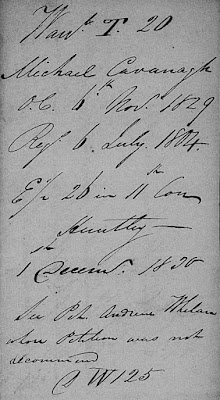 An intriguing question appeared in the
An intriguing question appeared in the ![Census of 1861, Canada West, Carleton, Township of Huntley, Enumeration District No. 7, p 23 [stamped]; RG 31; digital images, Library and Archives Canada, Library and Archives Canada (www.bac-lac.gc.ca : accessed 16 Feb 2022); citing Library and Archives Canada microfilm C-1013.](https://blogger.googleusercontent.com/img/a/AVvXsEidP_yIVJFxJ9LgLri07FDB-Jg3vAdsPOXV4sjoNL3NUNPXnEBWU2FUXrcHeEEhgB0v3kjo7p7HYnQnxENWgtTrKnWMm6ii9awxcTbnOqzbbuH4I_hoRdlFWEDa9BsWkg05IAR6HnWWN1hS5-AnMbBSSZ7gXYq4aoSuxYqzUVZ1wDbSHIbBiN14udeR=w400-h159)
!["Civil Secretary's Correspondence, Upper Canada Sundries, October-November 1823," page 1 of the petition of Michael Cavanagh, p. 32921 [stamped], image 781; digital images, Canadian Research Knowledge Network, Héritage (https://heritage.canadiana.ca/ : accessed 16 Feb 2022); citing Library and Archives Canada, RG 5, A 1, vol. 62, pp 32850-33396, Reel C-4611.](https://blogger.googleusercontent.com/img/a/AVvXsEj_VOYrXSQX-mAgkN76yerR60Qku8SEuU37Sb_oDoCKPK40kvR643qXHPQWCI0z9a129MviYL2MngINh1PGn8LhD_P1CkutiP2qepv_T_gcW6wjTzJhB01lA0pj8QFcx09sUi4l_MocAt7oszWzlnjj4w_8tctSSWBZ3ba95XZbzKHug_9zvnnQ-zfC=w288-h400)
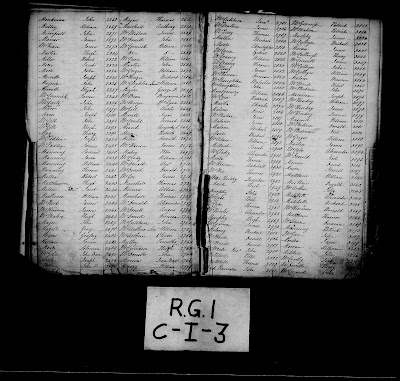

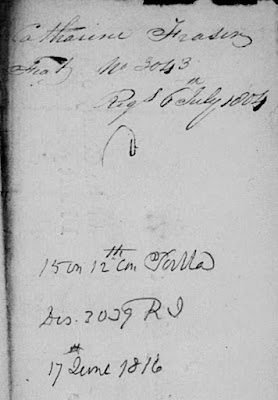

 For those with ancestors and relatives who were buried in several of the Toronto Trust cemeteries
For those with ancestors and relatives who were buried in several of the Toronto Trust cemeteries 

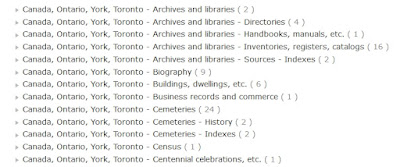

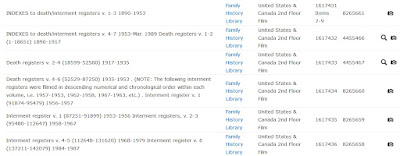
!["Index to Death Register, v. 2," FamilySearch, Images (www.familysearch.org : accessed 9 Feb 2022), p. 558, George Kaye Warrener [ name highlighted in a red box]; citing DGS 8265661, item 8, image 935 of 1113.](https://blogger.googleusercontent.com/img/a/AVvXsEiZ8EByxp1GcyQyRBGO4IluujsihcnJkrzunvVxuiH8PtB_jfytwg4CDMx60r8t3a-FxT-cSMq5XPqDagx1126sHUBoFIjz6SiZNDSnOFeLvNtK_m_C6gl1mN6Xiv66AvAaiba3jLw6XbbFiO-AFo5VDB83idNFtnicIGhOQRvRsiBGFRfhxdpejZNF=w400-h127)


